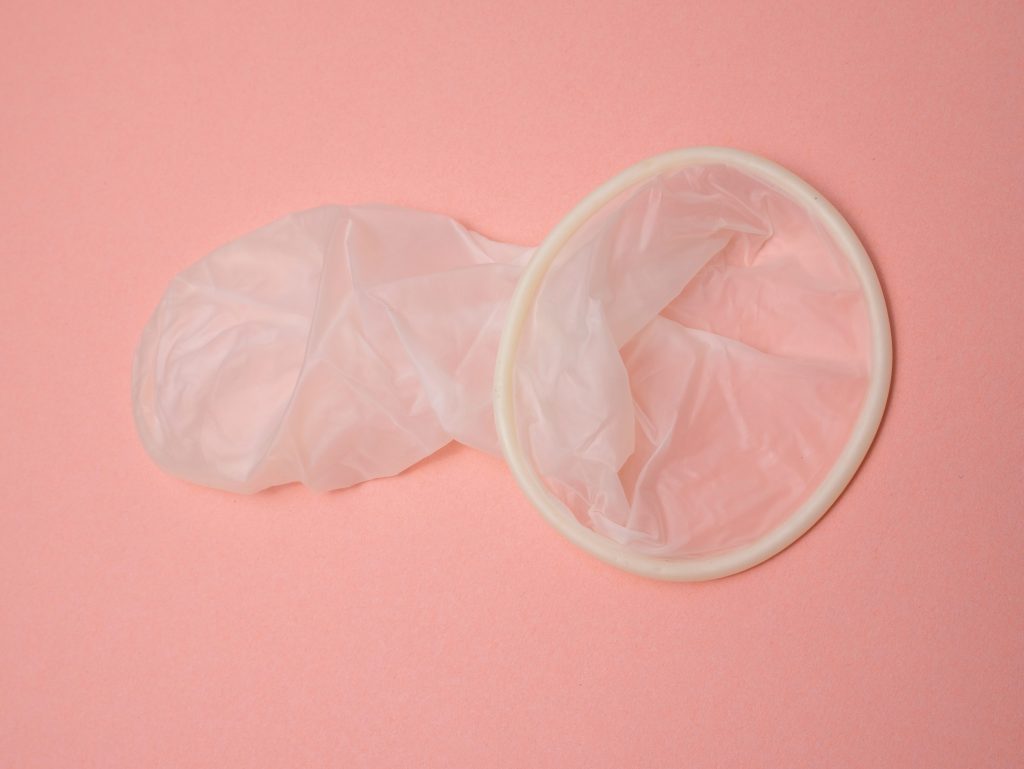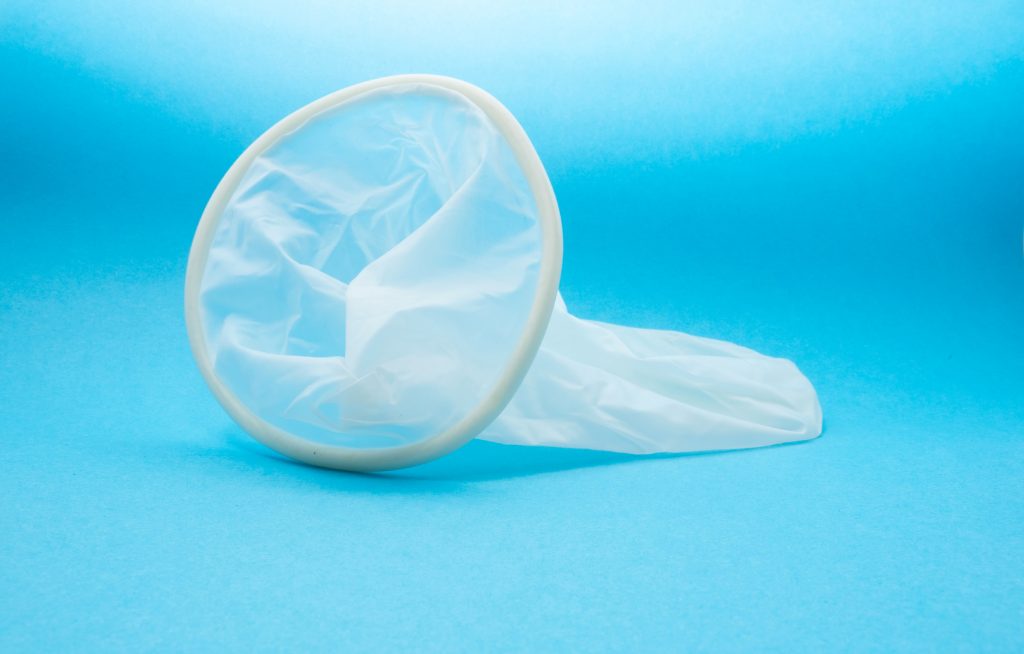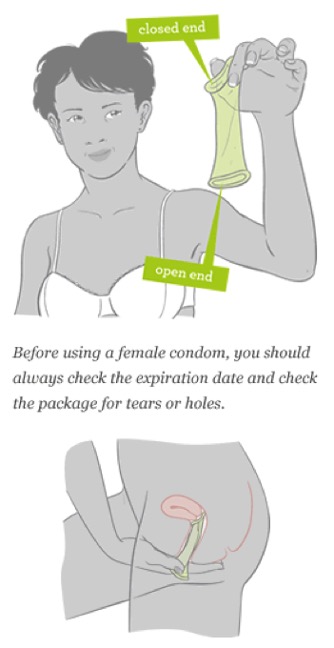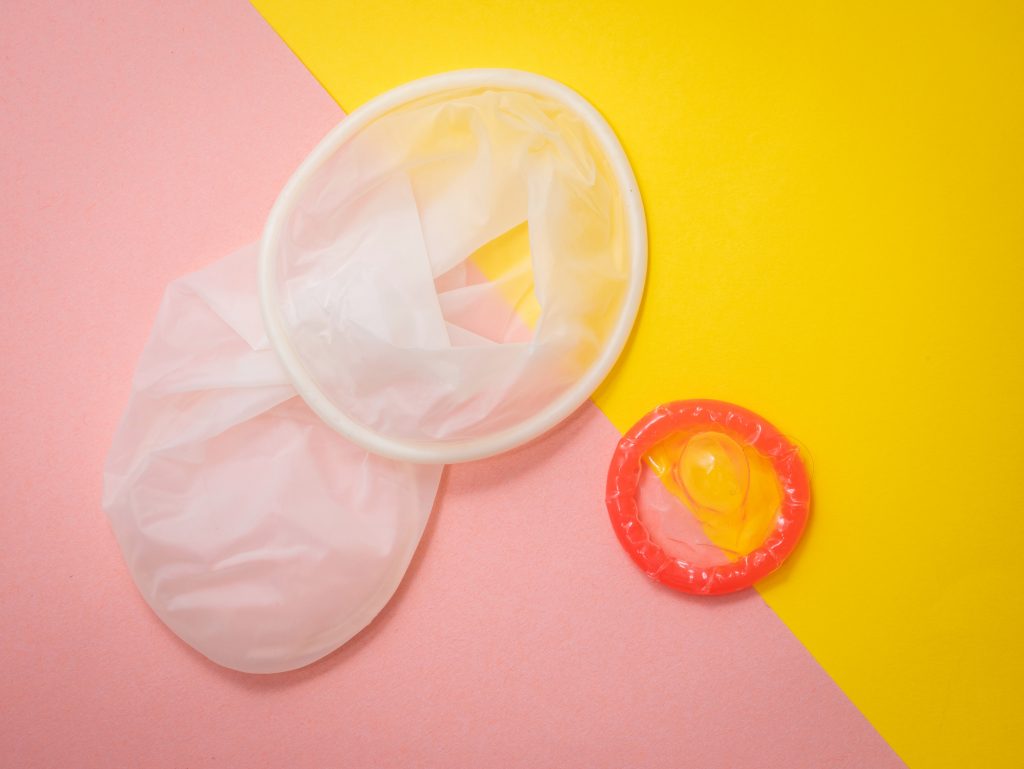
The internal condom, like the external condom, is a barrier method of contraception. When worn during sex, the internal condom lines the entire interior of the vagina, preventing semen from entering the uterus and potentially fertilizing an egg. By shielding the walls of the vagina or anus from semen and other bodily fluids, the internal condom also helps to prevent sexually transmitted infections (STIs).1
The internal condom is also commonly referred to as the ‘female condom’ because the condom is worn inside the vagina. In this article, however, we will avoid using gendered language in order to be as inclusive as possible. We believe this is important because not everyone who wears the internal condom, or who has a vagina, identifies as female, and not everyone who identifies as female has a vagina.
Table of Contents
The Two Main Types of Internal Condoms
The original internal condoms, also known as the female condoms (FC, or FC1), were made of a thin polyurethane sheath and were produced by brands such as Reality, Femy, and Femidom. However, due to the high cost of polyurethane production, makers of the internal condom released the second iteration of the condom — the FC2 internal condom — which became available for sale worldwide in 1993, but was not approved by the Food and Drug Administration (FDA) until 2009. Production of the original version of the internal condom has now stopped completely.2
The current version of the internal condom, the FC2, is the first and only FDA-approved contraceptive that gives people with uteruses the opportunity to prevent both unintended pregnancies and the spread of STIs.3 Unlike the external condom (sometimes referred to as the ‘male condom’) or the original FC internal condom, the FC2 is composed of a nitrile sheath or pouch that measures 17 centimeters in length, with a diameter of 7.8 centimeters.4 At each end of the condom is a flexible ring. The ring that is inserted into the vagina helps seat the base of the condom near the cervix during intercourse, while the ring at the opposite end of the condom stays outside the vaginal entrance. The outer ring serves as a guide during penetration and prevents the sheath from being pushed into the vagina. The interior of the condom contains a silicone-based lubricant, but additional lubricant can be used if necessary or desired. Unlike other types of barrier methods of contraception designed for people with vaginas (such as the diaphragm or the contraceptive sponge), the FC2 does not contain any spermicidal gel.4
Effectiveness
The internal condom is about 79% effective in preventing pregnancy with typical use.3 Typical use reflects how a method of birth control is used in the real world, accounting for an average amount of human error. By contrast, perfect use reflects what happens when a method of contraception is used correctly all of the time. With perfect use, the efficacy of the internal condom rises to 95%.3 Like external condoms, internal condoms may fail for the following reasons:

- The condom can rip or tear before or during intercourse.
- The condom is not worn before the penis touches the vagina.
- A new condom is not used for each sexual encounter.
- The condom has manufacturing defects. This is very rare.
- Semen spills from the condom during removal.5
To help prevent some of these risks, one should be sure to use an internal condom prior to its expiration date. One should also check the condom and its package prior to use, and dispose of the condom if any damage to either the packaging or the condom has occurred.
The internal condom significantly reduces the risk of many sexually transmitted infections. A study published in March of 2020 found that internal condoms were as effective as external condoms in preventing the transmission of HIV.6
Other Types of Internal Condoms
In recent years, numerous new models of internal condoms have been developed. In the United States, the FC2 internal condom is the only one that has been approved by the FDA. The following are brands of internal condoms that are available outside the United States.
VA W.o.W. Condom Feminine
The VA W.o.W. internal condoms are unique because they have a sponge on the inner end of the condom that helps hold the condom in place when it is inserted.7 The VA W.o.W. internal condom is currently available for purchase online in Europe. According to VA W.o.W’s 2019 press release, the condom was expected to be made available in the US by the end of the year, but as of now it is still pending FDA approval.7
The Woman’s Condom
The Woman’s condom was developed by PATH, a global nonprofit focused on improving public health, and is currently manufactured in Shanghai, China and is available for purchase in China, Europe, Malawi, South Africa, and Zambia. According to PATH’s website, this version of the internal condom is easy to insert, secure during use, and provides good sensation and comfort for both partners.8
Insertion
Anyone can learn to use internal condoms safely and easily. It is very likely that almost any person who can use a tampon can use an internal condom. With a bit of practice, one can learn to insert internal condoms with relative ease. Instructions for inserting the FC2 internal condom are listed below:

- Remove tampons before inserting the condom.
- Open the condom wrapper very carefully by tearing the notch at the top right corner. Do not use scissors, a knife, or teeth to prevent risk of an accidental puncture.
- Choose a comfortable position for insertion. You may want to squat, raise one leg, sit on a chair or stool, or lie down.
- Make sure the condom is well lubricated on the outside.
- The outer ring at the open end of the sheath is used to cover the vulva. Make sure the inner ring is situated at the end of the condom.
- Hold the condom by the inner ring, with the open end hanging down.
- Squeeze the inner ring with the thumb and middle fingers, so it becomes long and narrow.
- Gently insert the inner ring into the vagina (so you feel the inner ring move into position near the cervix).
- Using your finger, push the inner ring into the vagina as far as it will go.
- Check that the sheath is inserted straight and is not twisted. The outer ring should remain outside the vagina.
- The internal condom is now in place and ready for use.1,3
Instructions for inserting the VA W.o.W. internal condom are the same.7 However, if you are using the VA W.o.W, internal condom, ensure that any additional lubricants being used in conjunction are not oil based, as this can degrade the latex of the condom. Additionally, if you wish to use an internal condom for anal sex, follow the same instructions for insertion.
Removal
In order to remove the internal condom, squeeze and twist the outer ring while gently pulling out the condom. Wrap it in the original wrapper or a tissue, and dispose of the condom in the trash. Do not flush it down the toilet because it may cause clogging and will have to be retrieved manually.1,3
Helpful Tips

Some might think that using an external condom and an internal condom simultaneously will double protection. However, it is crucial to understand that this assumption is NOT TRUE. The friction between the two condoms will make them both more likely to tear.3,9
During Intercourse
The penis should be guided into the internal condom to prevent the penis from entering the vagina outside of the condom.3 Do not worry if the condom moves from side to side. If the penis slips out of the condom into the vagina, it should be withdrawn immediately and inserted into the condom once again. Using additional lubricant can help decrease the frequency of this occurrence.
If there is an accidental ejaculation outside the condom into the vagina, one may consider emergency contraception. One may also consider emergency contraception if the condom is torn or punctured upon removal.
Use each condom only once. The World Health Organization recommends using a new condom for each sexual encounter. Likewise, the FDA states that the internal condom is designed and intended only for a single-use.
Advantages
Internal condoms are a safe, convenient, and effective alternative to other methods of birth control. People of all genders like the internal condom for a wide range of reasons, some of which are listed below:
- Internal condoms provide people with vaginas the opportunity to share the responsibility of contraception with their partners.
- People with vaginas can use the condom and protect themselves from risk if their partners would rather not or refuse to be the one responsible for contraception.
- It stays in place whether or not a partner maintains their erection.
- The internal condom protects against pregnancy and most STIs if used correctly. In fact, internal condoms provide better protection against the transmission of skin-to-skin STIs like herpes (HSV) and human papillomavirus (HPV) because they cover more of the labia than other forms of barrier methods, including external condoms.
- The condom can be inserted prior to sex so as not to disturb foreplay; it can also be inserted during sex as part of foreplay.
- The external ring can stimulate the clitoris during intercourse and enhance pleasure.
- Internal condoms do not affect the wearer’s natural hormones.
- No prescription is required to obtain one.1,3
There are also other benefits that are specific to the FC2 internal condom, which are listed below:
- The nitrile construction allows it to be used by people who are allergic to latex.
- It can be used with both oil- and water-based, as well as silicone lubricants.
- It does not require special storage requirements because nitrile is not susceptible to degradation by variations of temperature or dampness.
- Nitrile is a good conductor of heat, so sensation is usually well-maintained during intercourse.
The internal condom is an immediately reversible method of contraception, meaning as soon as it is removed, the user is able to attempt to conceive. Because of this, as well as the added benefit that allergies to nitrile are rare,9 one can easily experiment with an internal condom to decide if it is a good fit for them and their sexual partner(s).
Disadvantages
As with any other type of contraception, there are some disadvantages to internal condoms, some of which are below:
- The outer ring or frame is visible outside the vagina and can make some users self-conscious.
- The internal condom may squeak or make noise during intercourse.
- Some find the internal condom difficult to insert or remove.
- It has a higher failure rate than other non-barrier methods of contraception, such as the birth control pill. This is because it can tear and because the penis can be accidentally inserted outside of the condom during sex.
- In some countries, the internal condom may be in limited supply and cost more than the comparable external condom.
- The sensation during intercourse may be reduced.
- The condom may potentially fully slip into the vagina or anus during intercourse.
- The internal condom is not as effective at preventing the transmission of STIs as the external condom because there is the possibility that the penis will be inserted outside of the condom during sex.
As with any method of contraception, we recommend weighing the advantages against the disadvantages to determine if the internal condom is the right choice for you and your sexual partner(s).
Cost
The FC2 internal condoms are slightly more expensive than latex external condoms because they are made of nitrile, which is a costlier material. In the United States and online, a single internal condom costs two to three dollars, though they are generally sold in boxes of six or 12.3 Though prescriptions are not required to obtain internal condoms, if you have insurance, you may be able to get a prescription for them, which can reduce their cost or make them free of charge.1
Concluding Remarks
The internal condom is an excellent option for contraception. The internal and external condoms are the only options for contraception that also offer protection against sexually transmitted infections (STIs). Due to the fact it is made of nitrile, the FC2 internal condom can be a good alternative to the external condom for those who are allergic to latex. Additionally, the internal condom is a great method of contraception for people with vaginas who do not wish to use hormonal methods but want to be in control of their contraception. As with any form of contraception, there are disadvantages to the internal condom as well. We recommend considering the benefits as well as the costs to determine if the internal condom is right for you. If you are still unsure, you may also find it helpful to consult with your physician about your options for contraception.
References
- “Birth Control Method: Internal Condom.” Bedsider.
- Mogale, R., Mulaudzi, F. M., Peu, M.D., Mataboge, M.S., Nagunyulu, R., &Phiri, S.S. “The constraints and concerns regarding the size and/or shape of the second generation female condom: The narratives from the healthcare providers” National library of Medicine. May 31, 2016.
- “Internal Condom.” Planned Parenthood.org.
- Monekosso, H. T. “The female condom: What about its safety, effectiveness and accessibility?” National Library of Medicine. June 1997.
- “Female Condoms: Your contraception guide” NHS. April 16, 2021.
- Wiyeh, A. B., Mome, R. K. B., Mahasha, P. W. Kongnyuy, E. J., & Wiysonge, C. S. “Effectiveness of the female condom in preventing HIV and sexually transmitted infections: A systematic review and meta-analysis” BMC Public Health. March 12, 2020.
- “VA Condom” VA W.o.W.
- “Woman’s Condom achieves WHO/ UNFPA prequalification” PATH.
- “The Female Condom” Mayo Clinic. Feb 11, 2020.
Last Updated: 24 May 2022.
